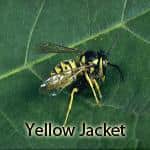Call Us Now: 330-832-4642 | 330-494-8873

Size: 1/2 inch
Color: Yellow and black stripes
Where found: Paper nests or mud tubes in protected areas
Potential treatment: Exterior Spray
Yellow jackets are thought by many to be bees, but they are wasps. Their appearance is much like a bee, however, at 1/2 inch long with alternating bands of yellow and black on their bodies, and workers are often confused with honey bees.
Queen yellow jackets are a bit larger. They typically appear in late spring and build a paper nest-chewed wood fiber-with 30 to 50 cells in which to deposit eggs. Preferred nesting areas are protected spaces, which can be trees, shrubs, under wood structures and under eaves, but they also may be underground within rodent burrows. Colonies grow to include thousands of workers, with the queen remaining inside laying eggs in tens of thousands of cells.
Yellow jackets will aggressively protect their nests, making ground level nests especially dangerous to homeowners tending to or entertaining in their yards. These insects can sting repeatedly, although like most bees and wasps, their venom is dangerous only to those who are allergic.
Workers are responsible for finding food for the queen and larvae. Yellow jackets eat caterpillars, grubs and other insects, as well as sweet substances, including plant and fruit juices, and tree sap. They also are attracted to human food and will become aggressive if their food supply dwindles due to seasonal issues or growth of the colony.